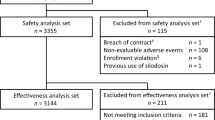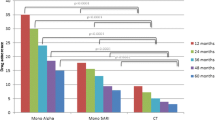Abstract
Medical therapy for benign prostatic hyperplasia (BPH) attempts to duplicate the known benefits of prostatectomy without the associated morbidity. The major goals of treatment for BPH include the relief of bothersome voiding symptoms and the prevention of disease progression. Despite the abundance of clinical data regarding the medical treatment for BPH during the past 20 years, a consensus regarding the best treatment regimen has not been reached. Recently, data from the largest randomized, prospective, placebo-controlled trial (MTOPS) evaluating the long-term progression of BPH-related voiding dysfunction were released. After a mean follow-up time of more than 4 years, combination therapy with α receptor antagonists (ARA) and 5-α reductase inhibitors (5-ARI) was found to be superior to monotherapy, with ARA or 5-ARI for the prevention of BPH-related disease progression. These compelling data from the MTOPS group should be considered when initiating a medical treatment plan for patients with BPH-related voiding dysfunction.
Similar content being viewed by others
References and Recommended Reading
Bartsch G, Muller HR, Oberholzer M, et al.: Light microscopic stereological analysis of the normal human prostate and of benign prostatic hyperplasia. J Urol 1979, 122:487–489.
Walsh PC: Benign prostatic hyperplasia. In Campbell’s Urology, edn 5. Edited by Walsh PC, Gittes RF, Perlmutter AD, Stamey TA. Philadelphia: WB Saunders; 1986:1248–1265.
Isaacs JT, Coffey DS: Etiology and disease process of benign prostatic hyperplasia. Prostate 1989, 2 (suppl):33–50.
Berry SJ, Coffey DS, Walsh PC, et al.: The development of human prostatic hyperplasia with age. J Urol 1984, 132:474–479.
Jacobsen S, Girman C, Guess H, et al.: New diagnostic and treatment guidelines for benign prostatic hyperplasia. Arch Intern Med 1995, 155:477–481.
Health Care Financing Administration: B.E.S.S. Data, Washington, DC, 1997.
Jepsen JV, Bruskewitz RC: Clinical manifestations and indications for treatment. In Prostatic Diseases. Edited by Lepor H. Philadelphia: WB Saunders; 2000:127–142.
Shapiro E, Lepor H: Pathophysiology of clinical BPH. Urol Clin North Am 1995, 22:285–290.
Caine M: The present role of alpha-adrenergic blockers in the treatment of benign prostatic hypertrophy. J Urol 1986, 136:1–4.
Shapiro E, Hartano V, Lepor H: The response to alpha blockade in benign prostatic hyperplasia is related to the percent area density of prostate smooth muscle. Prostate 1992, 21:297–307.
Caine M, Perlberg S, Meretyk S, et al.: A placebo controlled double blind study of the effect of phenoxybenzamine in benign prostatic obstruction. Br J Urol 1978, 50:551–554.
Lepor H, Auerbach S, Puras-Baez A, et al.: A randomized multicenter placebo controlled study of the efficacy and safety of terazosin in the treatment of benign prostatic hyperplasia. J Urol 1992, 148:1467–1474.
Gillenwater JY, Conn RL, Chrysant SG, et al.: Doxazosin for the treatment of benign prostatic hyperplasia in patients with mild to moderate essential hypertension: a doubleblind, placebo-controlled dose response multicenter study. J Urol 1995, 154:110–115.
Boyle P, Robertson C, Manski R, et al.: Meta-analysis of randomized trials of terazosin in the treatment of benign prostatic hyperplasia. Urology 2001, 58:717–722.
Lepor H, for the Tamulosin Investigator Group: Phase III multicenter placebo controlled study of tamulosin in benign prostatic hyperplasia. Urology 1998, 51:892–900.
Foglar R, Shibata K, Hirasawa A, et al: Use of recombinant alpha 1 adrenoreceptors to characterize subtype selectivity of drugs for the treatment of prostatic hypertrophy. Eur J Pharmacol 1995, 288:201–207.
Roehrborn CG: Are all alpha-blockers created equal? An update. Urology 2002, 59(suppl 1):3–6.
McVary KT: Medical therapy for benign prostatic hyperplasia progression. Curr Urol Rep 2002, 3:269–275.
McConnell J: The impact of medical therapy on the clinical progression of BPH: results of the MTOPS trial. J Urol 2002, Abstract 1042 (Updated):265. This landmark, long-term, prospective study demonstrated the use of combination therapy for the prevention of BPH-related disease progression.
McConnell JD: Medical management of benign prostatic hyperplasia with androgen suppression. Prostate 1990, 3 (suppl):49–59.
Moore E, Bracken B, Bremner W, et al.: Proscar: 5-year experience [published erratum appears in Eur Urol 1996, 29: 234 Eur Urol 1995, 28:304–309.
McConnell JD, Bruskewitz R, Walsh P, et al.: The effect of finasteride on the risk of acute urinary retention and the need for surgical treatment among men with benign prostatic hyperplasia: finasteride long-term efficacy and safety study group. N Engl J Med 1998, 338:557–563.
Gormley GJ, Stoner E, Bruskewitz RC,et al.: The effect of finasteride in men with benign prostatic hyperplasia. N Engl J Med 1992, 327:1185–1192.
Finasteride Study Group: Finasteride (MK-906) in the treatment of benign prostatic hyperplasia. Prostate 1993, 22:291–299.
Foley SJ, Soloman LZ, Wedderburn AW, et al.: A prospective study of the natural history of hematuria associated with benign prostatic hyperplasia and the effect of finasteride. J Urol 2000, 163:496–498.
Lepor H, Williford WO, Barry MJ, et al.: The efficacy of terazosin, finasteride, or both in benign prostatic hypertrophy. N Engl J Med 1996, 335:533–539. First well-designed trial evaluating the use of combination therapy compared with monotherapy for men with BPH-related LUTS. This shortterm trial proved to have no advantage of combination therapy over monotherapy with ARA or 5-ARI.
Roehrborn C: Categorical flow rate changes in men with LUTS and BPH treated with doxazosin, finasteride, or combination versus placebo in the Predict trial [abstract]. J Urol 2000, 163:1374. Well-designed, short-term trial that showed no advantage of combination therapy over monotherapy for the treatment of BPH-related LUTS.
Kirby R, Altwein JE, Bartsch G, et al.: Results of the PREDICT (Prospective European Doxazosin and Combination Therapy) trial [abstract 1027] J Urol 1999, 161:266.
Debruyne FM, Jardin A, Colloi D, et al.: Sustained release alfuzosin, finasteride, and the combination of both in the treatment of benign prostatic hyperplasia. European ALFIN Study Group. Eur Urol 1998,34:169–175.
Author information
Authors and Affiliations
Rights and permissions
About this article
Cite this article
Gonzalez, C.M., McVary, K.T. The role of combination therapy for lower urinary tract symptoms secondary to benign prostatic hyperplasia. Curr Urol Rep 4, 276–281 (2003). https://doi.org/10.1007/s11934-003-0084-1
Issue Date:
DOI: https://doi.org/10.1007/s11934-003-0084-1




